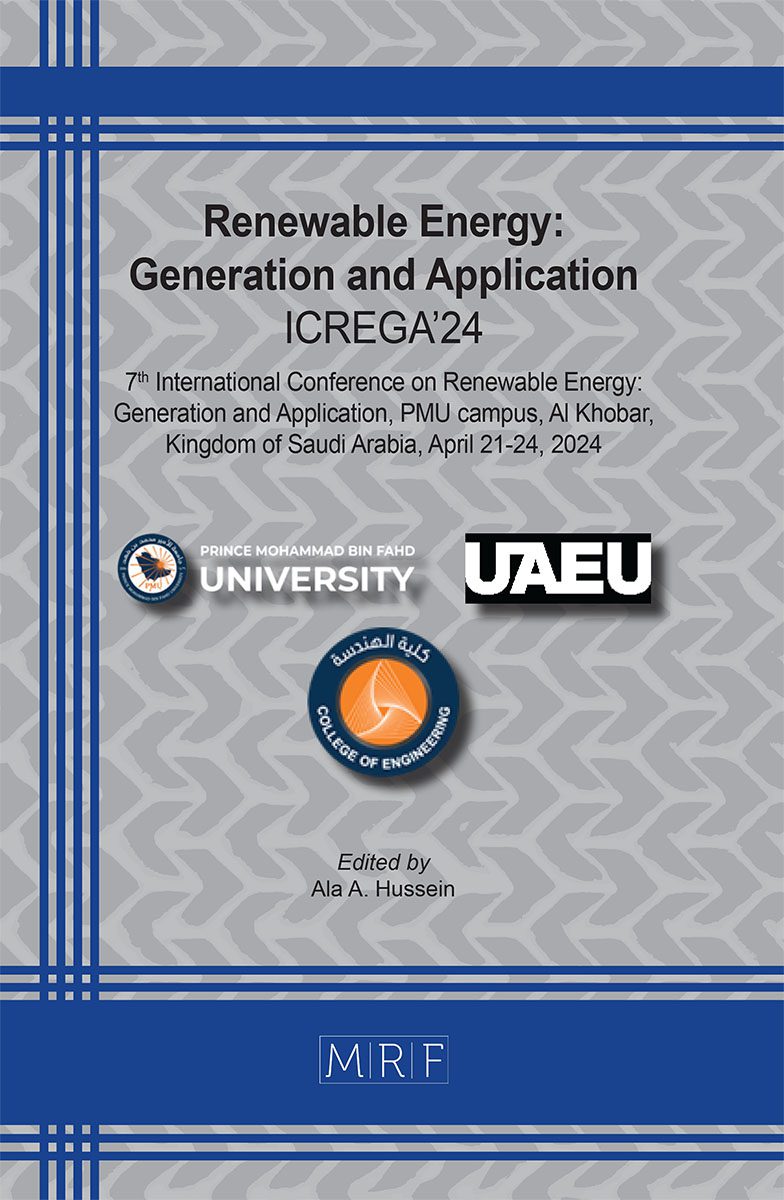–
Electroluminescence image-based defective photovoltaic (solar) cell detection using a modified deep convolutional neural network
Hiren MEWADA, L. SYAMSUNDAR, Hiren Kumar THAKKAR, Miral DESAI
download PDFAbstract. Electroluminescence (EL) imaging of photovoltaic solar cells can detect and classify solar panel faults. This method allows technicians and manufacturers to identify defective panels that may affect performance and longevity. However, noise in EL images and solar cell silicon granularity make this process difficult. The paper presents an automated deep-learning framework to identify faulty and normal solar cells from images. Xception, a popular CNN network, is modified to reduce complexity and solve overfitting issues. Few separable convolution layers were removed from the original Xception network, and lateral dropout layers were added. The proposed deep CNN is tested on ELVP. To balance two classes, images are augmented with two rotations and dimensional shifting. Finally, the proposed model is compared to a pretrained CNN network and leading methods. The quantitative analysis showed that the model performed better than previous methods, with 94.382% accuracy, 92% precision, 95.12% recall rate, and 93.53% F1 score. Module fault identification helps with maintenance planning. Solar energy’s widespread adoption and growth as a renewable and sustainable power source may result.
Keywords
Renewable Energy, Photovoltaic Solar Panels, Deep Convolution Neural Network, Image Classification
Published online 7/15/2024, 8 pages
Copyright © 2024 by the author(s)
Published under license by Materials Research Forum LLC., Millersville PA, USA
Citation: Hiren MEWADA, L. SYAMSUNDAR, Hiren Kumar THAKKAR, Miral DESAI, Electroluminescence image-based defective photovoltaic (solar) cell detection using a modified deep convolutional neural network, Materials Research Proceedings, Vol. 43, pp 13-20, 2024
DOI: https://doi.org/10.21741/9781644903216-2
The article was published as article 2 of the book Renewable Energy: Generation and Application
![]() Content from this work may be used under the terms of the Creative Commons Attribution 3.0 license. Any further distribution of this work must maintain attribution to the author(s) and the title of the work, journal citation and DOI.
Content from this work may be used under the terms of the Creative Commons Attribution 3.0 license. Any further distribution of this work must maintain attribution to the author(s) and the title of the work, journal citation and DOI.
References
[1] W. Tang, Q. Yang, K. Xiong, and W. Yan, “Deep learning based automatic defect identification of photovoltaic module using electroluminescence images,” Solar Energy, vol. 201, pp. 453–460, May 2020. https://doi.org/10.1016/j.solener.2020.03.049
[2] M. W. Akram et al., “CNN based automatic detection of photovoltaic cell defects in electroluminescence images,” Energy, vol. 189, p. 116319, Dec. 2019.
[3] U. Jahn, M. Herz, M. Köntges, D. Parlevliet, M. Paggi, and I. Tsanakas, Review on infrared and electroluminescence imaging for PV field applications: International Energy Agency Photovoltaic Power Systems Programme: IEA PVPS Task 13, Subtask 3.3: report IEA-PVPS T13-12:2018. Paris: International Energy Agency, 2018.
[4] M. Dhimish, V. Holmes, and P. Mather, “Novel Photovoltaic Micro Crack Detection Technique,” IEEE Trans. Device Mater. Relib., vol. 19, no. 2, pp. 304–312, Jun. 2019. https://doi.org/10.1109/TDMR.2019.2907019
[5] D.-M. Tsai, S.-C. Wu, and W.-Y. Chiu, “Defect Detection in Solar Modules Using ICA Basis Images,” IEEE Trans. Ind. Inf., vol. 9, no. 1, pp. 122–131, Feb. 2013. https://doi.org/10.1109/TII.2012.2209663
[6] S. A. Anwar and M. Z. Abdullah, “Micro-crack detection of multicrystalline solar cells featuring an improved anisotropic diffusion filter and image segmentation technique,” J Image Video Proc, vol. 2014, no. 1, p. 15, Dec. 2014. https://doi.org/10.1186/1687-5281-2014-15
[7] J. Zhang, X. Chen, H. Wei, and K. Zhang, “A lightweight network for photovoltaic cell defect detection in electroluminescence images based on neural architecture search and knowledge distillation,” Applied Energy, vol. 355, p. 122184, Feb. 2024.
[8] Q. Liu, M. Liu, C. Wang, and Q. M. J. Wu, “An efficient CNN-based detector for photovoltaic module cells defect detection in electroluminescence images,” Solar Energy, vol. 267, p. 112245, Jan. 2024. https://doi.org/10.1016/j.solener.2023.112245
[9] D. Dwivedi, K. V. S. M. Babu, P. K. Yemula, P. Chakraborty, and M. Pal, “Identification of surface defects on solar PV panels and wind turbine blades using attention based deep learning model,” Engineering Applications of Artificial Intelligence, vol. 131, p. 107836, May 2024. https://doi.org/10.1016/j.engappai.2023.107836
[10] M. Sun, S. Lv, X. Zhao, R. Li, W. Zhang, and X. Zhang, “Defect Detection of Photovoltaic Modules Based on Convolutional Neural Network,” in Machine Learning and Intelligent Communications, vol. 226, X. Gu, G. Liu, and B. Li, Eds., in Lecture Notes of the Institute for Computer Sciences, Social Informatics and Telecommunications Engineering, vol. 226. , Cham: Springer International Publishing, 2018, pp. 122–132. https:/10.1007/978-3-319-73564-1_13.
[11] Md. R. Rahman, S. Tabassum, E. Haque, M. M. Nishat, F. Faisal, and E. Hossain, “CNN-based Deep Learning Approach for Micro-crack Detection of Solar Panels,” in 2021 3rd International Conference on Sustainable Technologies for Industry 4.0 (STI), Dhaka, Bangladesh: IEEE, Dec. 2021, pp. 1–6. doi: 10.1109/STI53101.2021.9732592.
[12] M. Köntges, S. Kurtz, C. Packard, U. Jahn, K. A. Berger, and K. Kato, Performance and reliability of photovoltaic systems: subtask 3.2: Review of failures of photovoltaic modules: IEA PVPS task 13: external final report IEA-PVPS. Sankt Ursen: International Energy Agency, Photovoltaic Power Systems Programme, 2014.
[13] L. Pratt, J. Mattheus, and R. Klein, “A benchmark dataset for defect detection and classification in electroluminescence images of PV modules using semantic segmentation,” Systems and Soft Computing, vol. 5, p. 200048, Dec. 2023. https://doi.org/10.1016/j.sasc.2023.200048.
[14] J. Wang et al., “Deep-Learning-Based Automatic Detection of Photovoltaic Cell Defects in Electroluminescence Images,” Sensors, vol. 23, no. 1, p. 297, Dec. 2022. https://doi.org/10.3390/s23010297.
[15] S. Deitsch et al., “Automatic classification of defective photovoltaic module cells in electroluminescence images,” Solar Energy, vol. 185, pp. 455–468, Jun. 2019. https://doi.org/10.1016/j.solener.2019.02.067.
[16] M. Y. Demirci, N. Beşli, and A. Gümüşçü, “Efficient deep feature extraction and classification for identifying defective photovoltaic module cells in Electroluminescence images,” Expert Systems with Applications, vol. 175, p. 114810, Aug. 2021. https://doi.org/10.1016/j.eswa.2021.114810.
“”












